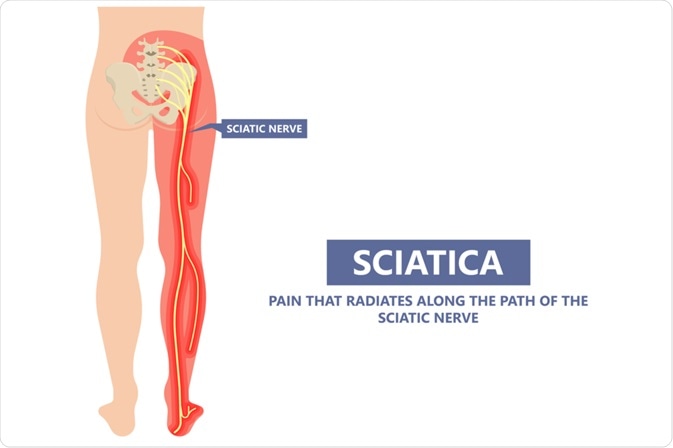Sciatica refers to pain in the thigh, leg, and buttock that arises due to pinching of the sciatic nerve.

Image Credit: rumruay / Shutterstock.com
The sciatic nerve is a large nerve is formed from a number of smaller nerves, which leave the spinal cord between neighboring spinal vertebrae. Once they join, the sciatic nerve passes into the buttock and then into the back of the thigh and the leg. It may be pressed against the underlying bone at different points on its journey from the spinal cord to the leg.
Symptoms
The affected person usually complains of numbness, a sensation of pins and needles, or pain that starts from the region of the hip and travels down the leg, pain or aching in the buttock, or in the ankle and foot. The pain may be excruciating and make normal functioning impossible or may be mild in nature.
Sciatica pain typically worsens when the person lifts, bends, or strains, and can thus occur with sneezing, coughing, or laughing heartily. It may also occur at night. Since the sciatic nerve controls both sensation and function of the leg muscles, sometimes the person experiences muscular weakness of the leg as well.
Causes of sciatica
Some of the possible causes of this nerve pain may include:
- A slipped or herniated lumbar disc
- Osteoarthritic changes in the lumbar spine with the growth of bony spurs, thickening of the spinal vertebrae, and narrowing of the discs. Each of these cause narrowings of the intervertebral space or the spinal canal, which can put pressure on the nerve roots which make up the sciatic nerve.
- Disc degeneration because of age-related changes
- Spinal injury or, rarely, a spinal tumor
- Inflamed or painful muscles in the buttock
Diagnosis and treatment
A diagnosis of sciatica is mainly made on the basis of the clinical symptoms and signs. In most cases, slipped discs heal within about 6 weeks to 3 months. Treatment consists of reduced activity and measures to reduce pain in the acute phase.
Total bed rest is not recommended, though it may be recommended that the affected individual takes a couple of days off from all heavy activity. Instead, gentle exercise or physiotherapy is beneficial to firm up the lower back, preferably in the pool, which takes the weight off the spine. Exercise helps relieve stiffness, keep the muscles strong, and helps you take up normal activity faster.
Pain-relievers and anti-inflammatories, ice packs, and warm baths help reduce acute pain. Other important treatment measures can include:
- Proper posture
- A firm mattress for back support
- Avoid bending, or lifting heavy things
- Sit in chairs with low back support
- Change position, or stand up, from time to time
- Improving your physical state
- Losing weight if overweight
X-rays or scans are not usually required unless the pain is severe, even a month after starting these measures. Of course, medical help is needed to decide when further investigation and treatment are needed.
In severe disc prolapse, epidural injections around the nerve roots are required to remove the pain. In some cases, disc surgery, or discectomy, is recommended. During this type of procedure, a small incision is made in the back muscles so that the unhealthy disc fragments that are pressing against the nerve roots can be removed. A discectomy has a 90% short-term relief rate, although recurrence occurs in about 5% of cases.
Complications of the nerve condition causing sciatica are rare. If there is severe pain, weakness or numbness, or loss of control over the bowel or bladder, it may indicate acute severe pressure on the spinal cord, requiring emergency treatment.
References
Further Reading
Last Updated: May 18, 2023